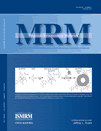Dual-echo Dixon imaging with flexible choice of echo times
Abstract
In this work, a new two-point method for water–fat imaging is described and explored. It generalizes existing two-point methods by eliminating some of the restrictions that these methods impose on the choice of echo times. Thus, the new two-point method promises to provide more freedom in the selection of protocol parameters and to reach higher scan efficiency. Its performance was studied theoretically and was evaluated experimentally in abdominal imaging with a multigradient-echo sequence. While depending on the choice of echo times, it is generally found to be favorable compared to existing two-point methods. Notably, water images with higher spatial resolution and better signal-to-noise ratio were attained with it in single breathholds at 3.0 T and 1.5 T, respectively. The use of more accurate spectral models of fat is shown to substantially reduce observed variations in the extent of fat suppression. The acquisition of in- and opposed-phase images is demonstrated to be replaceable by a synthesis from water and fat images. The new two-point method is finally also applied to autocalibrate a multidimensional eddy current correction and to enhance the fat suppression achieved with three-point methods in this way, especially toward the edges of larger field of views. Magn Reson Med, 2010. © 2010 Wiley-Liss, Inc.




